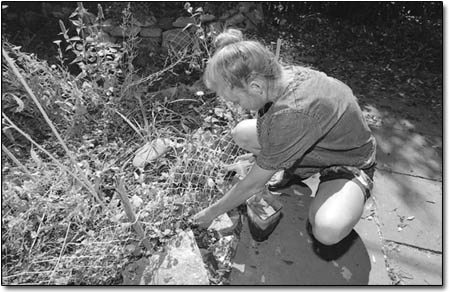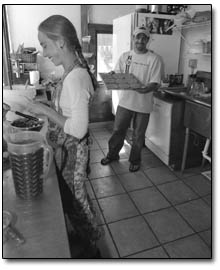|
Turtle Lake Refuge shares benefits
of 'living' foods
by Rachel Turiel Hinds
 |
| Katrina Blair picks
mint from the Turtle Lake Refuge garden./Photo by
Ben Eng |
A small revolution is taking place in Durango.
It simmers quietly in people’s back yards, where
they harvest dandelions, amaranth and other wild weeds.
It gathers steam in a historic district alley, where up
to 100 people each month eat wild and locally harvested,
raw-food lunches. And in the nearby woods, where people
are learning to pick and use the wild berries of summer
– chokecherries, serviceberries, hawthorn –
this revolution is on fire.
Katrina Blair, Durango native and founder and visionary
of Turtle Lake Refuge, is at the helm of this revolution.
In the past six years, Turtle Lake Refuge has been teaching
people the benefits of eating wild harvested, locally
grown and “living” (un-cooked) foods, all
of which they believe decrease the stress on our bodies
and the earth.
Blair is busy. Upon arriving at a benefit lunch last
week at the Rocky Mountain Retreat Center on East Third
Avenue, three people are waiting to see her. Someone needs
to confirm a date for a fund-raiser; a representative
from Food not Bombs wants to create an alliance with Turtle
Lake Refuge; and a Fort Lewis student delivers an update
on her efforts to get the campus food organization, Sodexho,
to offer some of Turtle Lake’s tasty treats.
Blair’s work, life and passions are so intertwined
that it is almost impossible to tell where work ends and
life starts. She is a rare person who makes work appear
effortless, lighthearted and continually fun. In fall,
a workday is often climbing an apple tree (after gaining
permission from the owner) and picking apples to be used
in the Turtle Lake benefit lunches, served twice a week.
In spring, tender dandelion leaves are plucked from mountain
meadows and backyard weed patches (unsprayed) for pesto,
salad or “wild weed power bars.” Blair admits
that she loves to harvest food, and just the sight of
her freezer’s contents – gallon jars full
of chokecherries, fresh-pressed apple juice, serviceberries
and the small, coveted bag of buffaloberries, all harvested
locally – makes her swoon.
The mission statement of Turtle Lake Refuge is “To
celebrate the connection between personal health and wild
lands.” The nonprofit aims to create a more sustainable
community by linking the value of a healthy internal environment
(our bodies) with a healthy external environment (the
earth). All the profits from their varied fund-raising
activities go toward preserving open space and sustainable
living practices.
Why local, wild and raw, and what does this mean?
“Locally grown foods minimize the resources required
for transporting our food from far away places,”
Blair explains. “This can mean buying from local
farmers, picking apples, or growing food in our own back
yards. Wild foods connect us to the land we
 |
| Tessa Canzona makes
“Silent Paradise Balls” while fellow “cook”
Gabe Eggers works on a tray of Flax Seed Crackers
in the Turtle Lake Kitchen./Photo by Ben Eng |
inhabit and provide one of the highest mineral sources
available. At our benefit lunches we try to include something
wild everyday, which could be a wild weed salad, hawthorn
berry pie or yucca fruit salsa, for example.”
Her mother, Pat Blair, who was diagnosed with arthritis
at age 17, introduced Katrina to raw food. The family
would eat entirely raw one day each week in an effort
to take the strain off their digestive systems and promote
general health. Doctors said Pat Blair would be in a wheelchair
by 40, though instead, she is free of arthritis. Many
people come to Turtle Lake because of chronic health issues,
including poor digestion and fatigue.
Eating raw food does not mean one is limited to carrot
sticks and apples, as many believe. When grains and beans
are sprouted (by soaking in water) they go from a dormant
seed to an activated, living food with nutrient content
greatly increased. Nuts, sprouted grains and beans are
used to make main courses, shaped by the imagination of
each individual chef at Turtle Lake Refuge. “Cheeses”
are often made from nuts pureed with a small amount of
water and miso and tossed with fresh spices and left to
ferment a day or two.
Like the swankest of big city restaurants, TLR has no
menu, simply one special of the day. Last Friday, Sissy
Mueller served up veggie burgers, sweet potato fries,
onion rings green salad and a slice of apple pie for dessert.
Unbelievably it’s all raw, and thoroughly delicious.
“It’s the All American meal ’cept good
for you,” Mueller laughs as she lays down meals
for a table of patrons. Mueller, who serves the Friday
meal and eats 100 percent raw, says she’s been serving
meals with themes that people can recognize, like the
Italian meal she served recently with an all-raw lasagna:
the noodles were made with thin slices of zucchini; sauce
was fresh, local tomatoes; and the cheese was a “mozzarella”
made from pine nuts and basil.
The daily lunch is determined entirely by what’s
in season and what is available. In the summer TLR draws
from many local gardens and of course wild land. The five
employees and three interns (who receive credit at FLC)
spend much of the summer harvesting wild foods and preserving
them for the winter. Berries get frozen, juiced or dried
into fruit leather. Foods frozen or dehydrated at less
than 120 degrees retain their living enzymes. Greens are
eaten fresh as much as possible, though large quantities
of dandelion, amaranth and mallow – the highly nutritious
bane of gardeners – are dried, powdered and added
to the popular “wild weed power bars.”
The lunch clientele is as eclectic as the food. Young,
pierced, patched and dreadlocked twentysomethings break
flax seed crackers with businesswomen and grandfathers.
As I sit and eat my lunch in the full room, topics among
the patrons range from college classes to menopause.
After polishing off my All American with a slice of raw
apple pie, Blair takes me into the kitchen where she needs
to prepare several trays of chokecherry macaroons for
the next day’s Farmers Market. The kitchen is small,
and there is a lot going on. Mueller is still cranking
out lunches (lunch is served from 11:11 a.m. – 2:22
p.m.), an intern is prying flax seed crackers off dehydrator
sheets, also for the Farmers Market, while lunch patrons
come in to hug the chefs, express their gratitude for
the meal, and get advice, encouragement, support from
Blair. She has time for everyone and everything.
As she blends chokecherries, dates, locally picked apples
and coconut flakes for a batch of cookies, Blair explains
some of the visions of the organization. She would like
to create a sustainable living education center on some
land, where college students intern for a semester, overseeing
the property, while teaching elementary through high school
students about sustainable life practices.
“Today’s kids have so much connection with
packaged potato chips and TV, wild things don’t
matter. If they slept under the stars, tasted wild berries,
I think things could change.”
There is land in the Animas Valley that TLR is interested
in, and Blair is not deterred by the price. After seeing
TLR grow from a one-woman show, running lunches out of
a tiny food court in The Smiley building, to a thriving
organization employing five people, three interns and
dozens of volunteers, she knows when the timing is right,
anything is possible.
For the past four years, Blair has been teaching a four-week
class called “Gourmet Living Foods.” In this
class people learn to sprout seeds at home and create
delicious, gourmet meals out of living foods. This summer
Blair put a twist on the
 |
| Kyle Conrad, left, and
Rachel Cooper, with baby Kahlil, cut and bag sunflower
sprouts Monday at the refuge./Photo by Ben Eng. |
usual class and offered “Living Foods on the Wild
Side,” in which people learned to identify wild,
edible plants and to prepare them right in the field.
When asked if she has any fears of exposing so many people
to wild foods, that they may deplete these resources,
Blair explains that 90 percent of what she teaches people
about and harvests for the benefit lunches are wild weeds,
which are in no danger of being over harvested.
“What happens in agriculture today is a farmer
plants one crop, after spraying the land with an herbicide
to remove all competing plants,” she says. “Not
only does this deplete nutrients and life from the soil,
but it decreases food for wild animals and pollinators.
When we plant our backyard gardens and farms organically,
we can harvest the weeds that grow without any additional
water, fertilizer or care, as well as our cultivated crops.
Plus, wild foods have the highest nutrients so you don’t
need to eat as much. I think the more we teach people
about wild food the more we can sustain them and achieve
a higher quality for life for everyone.”
Melinda Mical, a local nurse who works in cardiac rehab
has taken Blair’s Gourmet Living Foods class with
her husband and daughter. She has been incorporating raw
foods into her life for several years and feels that eating
raw has allowed her digestive system to heal and renew
itself, as well as her energy levels to rise.
After getting the macaroons in the dehydrator, Blair
discovers that someone soaked a gallon of oat groats thinking
they were wheat berries, which need to be sprouted for
wheatgrass. “Oat groats don’t sprout, so I
guess we won’t have wheatgrass for tomorrow 85 but
we could make cookies out of these.” Blair suggests.
Gabe Eggers, another employee nods, “how about carob
hawthorn berry cookies?”
“Yeah, with some fresh mint,” someone else
suggests. And a new recipe is born. This is how life works
here; when the floor drain overflows with water, you mop
the floor, when a basket of cookies is jostled at the
Farmers Market and each and every one breaks, you have
samples to share.
When your life, your work, your passions are all the
same, and you have a burning desire to share them, people
pay attention. Word spreads; enthusiasm grows. There is
a small revolution taking place in Durango.
|

